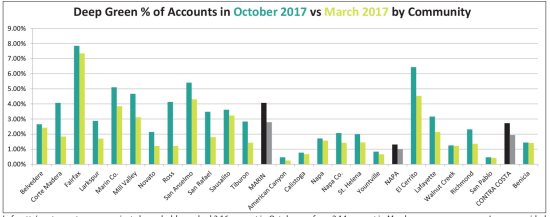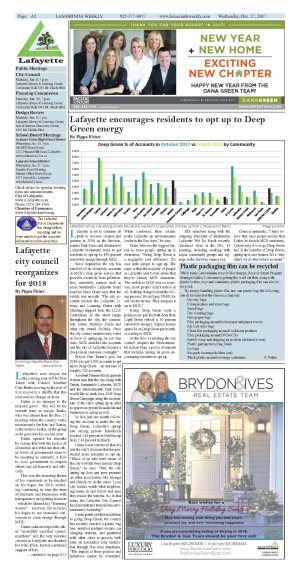| | Published December 27th, 2017
| Lafayette encourages residents to opt up to Deep Green energy
| | | By Pippa Fisher |  | | Lafayette's opt-up rate among private households reached 3.16 percent in October, up from 2.14 percent in March. Image provided |
Lafayette is set to continue its push to become cleaner and greener in 2018 as the Environmental Task Force and Sustainable Lafayette brainstorm ways to get residents to opt up to 100 percent renewable energy through MCE.
 Since September the city has enrolled all its electricity accounts in MCE's deep green service that provides electricity from pollution-free, renewable sources such as solar. Sustainable Lafayette board member Brad Crane says that the switch was smooth. "The city accounts include the Lafayette Library and Learning Center with (funding) support from the LLLC Foundation, all the street lamps throughout the city, the community center, Buckeye Fields and other city owned facilities. Once the city council unanimously voted in favor of opting up, its job was done. MCE switched the accounts and the city of Lafayette became a Deep Green customer overnight."
Since September the city has enrolled all its electricity accounts in MCE's deep green service that provides electricity from pollution-free, renewable sources such as solar. Sustainable Lafayette board member Brad Crane says that the switch was smooth. "The city accounts include the Lafayette Library and Learning Center with (funding) support from the LLLC Foundation, all the street lamps throughout the city, the community center, Buckeye Fields and other city owned facilities. Once the city council unanimously voted in favor of opting up, its job was done. MCE switched the accounts and the city of Lafayette became a Deep Green customer overnight."
 Mayor Don Tatzin's goal for 2018 is to get 1,000 accounts to opt up to Deep Green - an increase of roughly 700 accounts.
Mayor Don Tatzin's goal for 2018 is to get 1,000 accounts to opt up to Deep Green - an increase of roughly 700 accounts.
 Assistant Planner Julia Koppman Norton says that the city along with Tatzin, Sustainable Lafayette, MCE and the Environmental Task Force would like to push for a 2018 Deep Green Campaign using the momentum of the city's opting up in order to spur more private households and businesses to opt up as well.
Assistant Planner Julia Koppman Norton says that the city along with Tatzin, Sustainable Lafayette, MCE and the Environmental Task Force would like to push for a 2018 Deep Green Campaign using the momentum of the city's opting up in order to spur more private households and businesses to opt up as well.
 In fact, just one month following the decision to make the city Deep Green, Lafayette's opt-up rate among private households reached 3.16 percent in October, up from 2.14 percent in March.
In fact, just one month following the decision to make the city Deep Green, Lafayette's opt-up rate among private households reached 3.16 percent in October, up from 2.14 percent in March.
 Crane is not convinced that it's just the city's decision that has persuaded more residents to opt up. "Those of us who were aware of the city's switch were already Deep Green," he says. "But, the city opting up does put peer pressure on other local towns, like Moraga and Orinda, to do the same. Local city leaders watch what neighboring towns do and follow suit once they realize the benefits. So, in that sense, the Lafayette City Council has demonstrated tremendous environmental leadership."
Crane is not convinced that it's just the city's decision that has persuaded more residents to opt up. "Those of us who were aware of the city's switch were already Deep Green," he says. "But, the city opting up does put peer pressure on other local towns, like Moraga and Orinda, to do the same. Local city leaders watch what neighboring towns do and follow suit once they realize the benefits. So, in that sense, the Lafayette City Council has demonstrated tremendous environmental leadership."
 Crane points out that in addition to going Deep Green, the council has recently enacted a plastic bag ban, installed multiple electric car charging stations, and partnered with other cities to provide bulk rates on residential solar installation through Bay Area Sunshares. "The impact of these policies and initiatives cannot be overstated. When combined, these actions make Lafayette an environmental leader in the Bay Area," he says.
Crane points out that in addition to going Deep Green, the council has recently enacted a plastic bag ban, installed multiple electric car charging stations, and partnered with other cities to provide bulk rates on residential solar installation through Bay Area Sunshares. "The impact of these policies and initiatives cannot be overstated. When combined, these actions make Lafayette an environmental leader in the Bay Area," he says.
 Crane believes the biggest barrier to more people opting up is awareness. "Being Deep Green is a negligible cost difference. It's also quite simple to sign up. The issue is that the majority of people in Lafayette aren't even aware that they're already MCE customers. The switch to MCE was so seamless, most people didn't notice at all. Nothing changed about the billing process. We still pay PG&E for our electricity use. They just pass it on to MCE."
Crane believes the biggest barrier to more people opting up is awareness. "Being Deep Green is a negligible cost difference. It's also quite simple to sign up. The issue is that the majority of people in Lafayette aren't even aware that they're already MCE customers. The switch to MCE was so seamless, most people didn't notice at all. Nothing changed about the billing process. We still pay PG&E for our electricity use. They just pass it on to MCE."
 Going Deep Green costs a penny more per kilowatt-hour than Light Green (which is 50 percent renewable energy). Typical homes spend $4 on Deep Green per month, according to MCE.
Going Deep Green costs a penny more per kilowatt-hour than Light Green (which is 50 percent renewable energy). Typical homes spend $4 on Deep Green per month, according to MCE.
 At the Nov. 13 meeting the city council adopted the Environmental Action Plan, a policy document that includes among its goals encouraging residents to opt up.
At the Nov. 13 meeting the city council adopted the Environmental Action Plan, a policy document that includes among its goals encouraging residents to opt up.
 ETF members along with the outgoing President of Sustainable Lafayette Wei-Tai Kwok recently discussed ideas at the Dec. 14 meeting, including working with major community groups and signage in the Safeway banner box.
ETF members along with the outgoing President of Sustainable Lafayette Wei-Tai Kwok recently discussed ideas at the Dec. 14 meeting, including working with major community groups and signage in the Safeway banner box.
 Crane is optimistic. "I truly believe that once people realize that 1) they're already MCE customers, 2) how easy it is to go Deep Green and 3) the benefits of Deep Green, opting up is a no brainer. It's a 'why didn't we do this before' moment."
Crane is optimistic. "I truly believe that once people realize that 1) they're already MCE customers, 2) how easy it is to go Deep Green and 3) the benefits of Deep Green, opting up is a no brainer. It's a 'why didn't we do this before' moment."
 Plastic packaging film can be recycled
Plastic packaging film can be recycled

 While many Lamorindans recycle like champs, Recycle Smart Program Manager Ashley Louisiana is getting the word out that, along with plastic bottles, toys and containers, plastic packaging film can also be recycled.
While many Lamorindans recycle like champs, Recycle Smart Program Manager Ashley Louisiana is getting the word out that, along with plastic bottles, toys and containers, plastic packaging film can also be recycled.
 By simply bundling plastic film into one plastic bag, the following can all be tossed in the blue recycling bin:
By simply bundling plastic film into one plastic bag, the following can all be tossed in the blue recycling bin:
 Grocery bags
Grocery bags
 Clean produce and meat bags
Clean produce and meat bags
 Bread bags
Bread bags
 Dry cleaning bags
Dry cleaning bags
 Newspaper bags
Newspaper bags
 Film packaging around toilet paper and paper towels
Film packaging around toilet paper and paper towels
 Zip lock style bags
Zip lock style bags
 Clean film packaging around food/meat products
Clean film packaging around food/meat products
 Film packaging around DVDs/CDs
Film packaging around DVDs/CDs
 Bubble wrap and shipping air pockets (deflated is best)
Bubble wrap and shipping air pockets (deflated is best)
 Plastic garbage/recycling liners
Plastic garbage/recycling liners
 Ice bags
Ice bags
 Six-pack beverage holders (cut)
Six-pack beverage holders (cut)
 Thick plastic around beverage containers - P. Fisher
Thick plastic around beverage containers - P. Fisher


|
| | | | | | | | | | | | |



